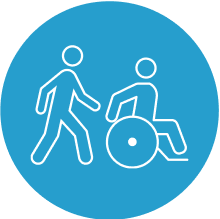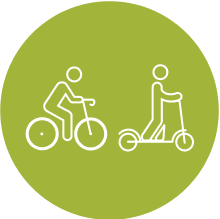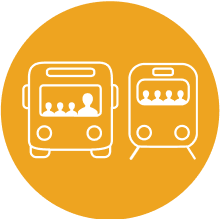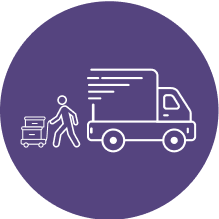INTRODUCTION
The Transportation Action Plan in context
The Minneapolis Transportation Action Plan (TAP) is a 10-year action plan to guide future planning, design, and implementation of transportation projects for all people however they choose to move around
The TAP supports the bold policies adopted in the Minneapolis 2040 Comprehensive Plan, which identifies transportation as a critical component to increase equity, address climate change, reduce carbon emissions, improve human health through improved air quality and increased active travel, and enable the movement of people, goods, and services across the City of Minneapolis (the City). We anticipate the changes made through the TAP will complement the land use changes envisioned through 2040 and work in tandem with these changes over time as the city evolves.
How we achieve the vision of Minneapolis 2040 depends upon our ability to define and then realize the value of our Minneapolis streets. Approximately 22% of the land area of the city is held in trust for the public within our streets (often called the public right of way). The TAP seeks to unlock the potential of our streets as places for people and as an invaluable asset for broader outcomes achieved by making the right investments in our transportation network. Our streets need to reflect our values of creating a more sustainable, equitable, safe, and prosperous city; the set of strategies and actions contained within this plan strives to make every journey contribute to that vision.
Transportation challenges
We can face our challenges by rethinking our streets. Minneapolis is a city that experiences disparities of wealth based on race. We are a cold weather city that experiences heavy snow, ice and rain storms. We have largely devoted our streets to the ease of access for vehicles over the past hundred years; as a result, pedestrians, people on bikes and people in cars die and suffer life-altering injuries each year. We are both contributing to climate change as well as experiencing the effects. These challenges cannot be solved through transportation alone, but the way the City plans and provides for transportation choices has an impact on all of them.
Goals to guide transportation decisions
There are six transportation goals that guide the strategies and actions developed in this plan:
 Climate
Climate  Safety
Safety  Equity
Equity  Prosperity
Prosperity  Mobility
Mobility  Active Partnerships
Active Partnerships
Topics
To reflect Minneapolis goals and values in our streets, the strategies and actions within this plan are focused on seven topics.

Walking
Promote a safe and inviting walking and rolling environment:
The plan identifies actions to make it easier, safer, and more comfortable for people to get around walking or rolling using a wheelchair, stroller or other assistive mobility device. Actions are focused on a Pedestrian Priority Network. All future references to “walking” in this document are inclusive of “walking and rolling” as defined above.
 Bicycling
BicyclingIncrease the availability and safety for bicycling and micromobility travel:
With an emphasis on establishing a low-stress network for all ages and abilities, the plan focuses on making the choice to bike or take other micromobility options easier for more people, as well as improving safety and comfort for those who ride.
 Transit
TransitDefine the Minneapolis transit network:
A quarter-million transit trips begin, end or travel through Minneapolis each weekday. Transit is a critical part of the City’s transportation network; the plan outlines strategies and actions to support a reliable, convenient and comfortable public transit network.
 Technology
TechnologyInvite new technology to advance transportation options:
Technology is changing the way we travel. The plan defines how to integrate technology and new business and service models. Shared scooters, bicycles, and electric vehicles are examples of new mobility options.
 Freight
FreightManage increased freight needs while preserving the street:
Freight is a critical component of our economy. The plan considers how raw materials, food, and packages are delivered to people and businesses every day in our city with strategies and actions to improve the sustainable and efficient movement of freight to, from and through Minneapolis.
 Street Operations
Street OperationsImprove street operations and address competing demands:
This topic further defines how the City's Complete Streets Policy, commitment to Vision Zero, and transportation goals come together into daily operations and transportation system planning. It provides a foundation for evaluating competing demands within limited street space by taking a comprehensive, people-first approach.
 Design
DesignDesign for people:
Streets are important community public spaces where we live, gather, travel, shop or wait for the bus, on a daily basis. We aim to design, build, and maintain streets that are safe, functional, and support the movement of people and goods throughout the city. Actions in this topic focus on the many ways streets need to serve people through design. The City’s Street Design Guide (to be released in 2020) is a companion document to the TAP and will identify street typologies and provide guidance for how we approach design on all streets within the city, with the exception of freeways.
The TAP replaces Access Minneapolis
The TAP replaces Access Minneapolis, and all its parts, in full. Access Minneapolis was developed between 2007-2011, with updates as recently as 2017. Access Minneapolis includes:
- Downtown Action Plan
- Citywide Action Plan
- Design Guidelines for Streets and Sidewalks1
- Streetcar Planning
- Pedestrian Master Plan
- Bicycle Master Plan
The TAP in relationship to the Vision Zero Action Plan
The City adopted a Vision Zero Action Plan in December 2019 that identifies strategies and actions across multiple City departments to make progress toward our goal of zero traffic-related deaths and severe injuries; the initial plan is for years 2020-2022 and will be updated as we make progress toward our goal. The TAP and its strategies and actions support the Vision Zero Action Plan by building off the work outlined in that plan. The specific Vision Zero strategies and actions are not repeated verbatim in this document, but rather assumes the City is working toward the strategies and actions in both plans simultaneously. Those strategies and actions articulated in the Vision Zero Action Plan are set for completion by 2022.
The TAP's influence on project prioritization and capital project development
The City prioritizes capital projects through the process and criteria identified as a part of its 20 Year Streets Funding Plan and publishes its multi-year plan of programmed projects annually through the Capital Improvement Program process. The TAP identifies new projects and programs that will be incorporated into the City’s existing approach to prioritizing, programming, and delivering transportation projects. Many projects in the TAP will require additional resources – staff time or funding – including those identified for near-term implementation (see Quick results section). The detail provided in the action plan also allows for us to apply for grant funding opportunities and potentially leverage other regional or national partnerships to achieve the actions identified.
Fiscal planning and implications
The TAP is not a fiscally constrained plan. There are strategies and actions with large financial impacts on the City and its partners. While we understand additional resources are needed, we are also adjusting our existing delivery of capital projects and programs to reflect the strategies and actions outlined and to capitalize on opportunities to value-engineer and creatively finance initiatives.
Relationship to other City and regional plans
Metropolitan Council Transportation Policy Plan
The Metropolitan Council developed a Transportation Policy Plan as a part of its regional development guide, Thrive MSP 2040, which sets the direction for the region’s growth and development. The most recent update to the Transportation Policy Plan was October 2018. The Transportation Policy Plan is a fiscally constrained plan that identifies regionally important projects. The TAP supports the Transportation Policy Plan and goes further to identify projects, some with regional impacts, which are important to the City of Minneapolis. Identification of some projects in the TAP may be incorporated into the Transportation Policy Plan in the future, in either the fiscally constrained portion or an increased revenue scenario.
Metro Transit Network Next
Metro Transit is an operating division of the Metropolitan Council and is the regional transit agency that operates most, but not all, of the transit service in Minneapolis.2 Metro Transit is currently developing a plan to guide the expansion of the regional bus network, called Network Next, and will develop a prioritized vision for the bus network of 2040, including the local and express bus network, arterial bus rapid transit network, and service quality investments like speed and reliability improvements and customer facilities.
The transit strategies and actions have been developed in coordination with Metro Transit and will be coordinated with the Network Next effort.
Minneapolis ADA Transition Plan for Public Works
The Minneapolis Americans with Disabilities Act (ADA) Transition Plan for Public Works details how the City complies with the 1990 Americans with Disabilities Act. The TAP works in tandem with the ADA Plan; as such, all projects and programs identified in the TAP will comply with the ADA. This plan goes farther in identifying ways the City can create greater access through improvements to our transportation network.
20 Year Streets Funding Plan
The 20 Year Streets Funding Plan (approved in 2016, updated in 2018) details the process and criteria for how the City selects street improvement projects for inclusion in the annual Capital Improvement Program. The 20 Year Street Funding Plan is not superseded by the TAP; rather, the TAP helps inform how we design and operate our streets, as well as identifies additional projects outside of the typical reconstruction process that are prioritized for development. The 20 Year Street Funding Plan significantly changed the way the City identifies projects for inclusion in the Capital Improvement Program: streets are selected based on a methodology that gives approximate equal weight to asset condition and equity considerations – both community demographics and uses and modes. The methodology developed for the 20 Year Street Funding Plan has influenced individual project selection in capital programs as well, such as the Pedestrian Safety and Sidewalk Gap programs. Building equity in as a core part as to where investment occurs in the city is critical for advancing citywide goals around racial and economic equity.
Next read about the City's Racial Equity Action Plan
- The Design Guidelines for Streets and Sidewalks will remain in effect until the completion of the Street Design Guide, which is anticipated to be complete in early 2021.
- Other transit service is provided by Minnesota Valley Transit Authority, SouthWest Transit, and other transit providers that serve cities and counties in the region who opted-out of Metro Transit service.

